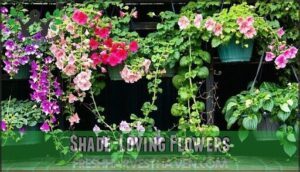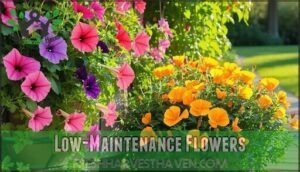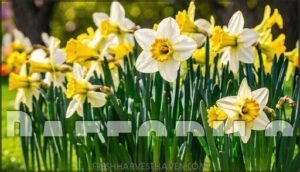This site is supported by our readers. We may earn a commission, at no cost to you, if you purchase through links.

These colorful champions bounce back from neglect and reward you with blooms all season long. Marigolds repel pests while adding bright orange and yellow pops. Zinnias come in rainbow colors and attract butterflies.
Sunflowers create natural privacy screens and feed birds. For shady spots, try impatiens and begonias that flourish without full sun.
Most need basic watering and well-draining soil to succeed. The secret lies in choosing varieties that match your garden’s conditions and your maintenance style, which is crucial for the flowers to thrive with minimal fuss and basic watering.
Table Of Contents
- Key Takeaways
- Easy Summer Garden Flower Ideas
- 10 Best Flowers for Your Summer Garden
- Sun-Loving Flowers
- Shade-Loving Flowers
- Low-Maintenance Flowers
- Fragrant Flowers
- Daffodils, Asters, and More
- Flowers for a Dreamy Garden
- Beyond The Basics: Flower Care Tips
- Frequently Asked Questions (FAQs)
- What is the easiest flower to bloom all summer?
- What are the best low maintenance flowers?
- Which flowers last the longest in summer gardens?
- What flower grows best in summer?
- How do I Make my Garden a summer-blooming garden?
- How do you keep flowers blooming in the summer?
- What are the best summer flowers to grow?
- What flowers go well with a summer garden?
- Are summer flowers hard to grow?
- What flowers bloom in summer?
- Conclusion
Key Takeaways
- You’ll succeed with drought-tolerant varieties like zinnias, marigolds, and sunflowers that thrive in heat and require minimal watering once established.
- You can create stunning displays in any light condition by choosing sun-lovers like cosmos for bright spots and shade-tolerant impatiens or begonias for darker areas.
- You’ll save time and effort by selecting self-seeding flowers like sweet alyssum and cosmos that naturally spread and return next year without replanting.
- You’ll maximize blooms with simple maintenance like weekly deadheading, deep watering twice weekly, and choosing varieties that match your garden’s soil conditions.
Easy Summer Garden Flower Ideas
Creating stunning summer blooms doesn’t require green thumb wizardry.
You’ll discover drought tolerant plants like zinnias, sunflowers, and marigolds that flourish with minimal fuss.
These easy summer flowers deliver maximum impact while conserving water and time.
Smart flower choices mean less stress and more beauty.
Heat tolerance keeps your garden designs vibrant through scorching days.
These low maintenance flowers practically plant themselves, giving you summer blooming flowers that thrive on neglect rather than constant attention.
By incorporating sustainable gardening practices, you can further enhance the beauty and resilience of your summer garden.
10 Best Flowers for Your Summer Garden
Ten carefully selected summer blooms will transform your garden into a vibrant paradise.
These flowers deliver stunning results with minimal effort, making summer garden ideas accessible for everyone.
Easy to grow annuals like zinnias and marigolds provide continuous color throughout the hot months.
Heat tolerance guarantees these summer garden flowers thrive despite scorching temperatures.
Drought tolerant plants reduce watering needs while maintaining beautiful blooms.
The best flower choices for your garden designs include:
- Zinnias – Bold blooms in every shade imaginable, perfect for cutting
- Marigolds – Pest-fighting powerhouses that bloom nonstop
- Cosmos – Delicate dancers that sway gracefully in summer breezes
These low maintenance flowers adapt to various soil conditions and require minimal care.
Their drought resistance makes them ideal for busy gardeners seeking maximum impact with minimal effort.
Sun-Loving Flowers
Sun-loving flowers thrive in bright, direct sunlight and need minimal care once established. You’ll find these hardy blooms perfect for creating vibrant displays that handle summer heat with ease.
Marigolds
Marigolds stand out as the ultimate beginner-friendly choice for easy summer flowers. These drought-tolerant plants deliver vibrant summer blooms in shades from golden yellow to deep burgundy red.
Marigolds: the golden guardians that bloom boldly while keeping garden pests at bay with cheerful determination.
Marigold varieties offer options for every garden design. French marigolds stay compact at 6-12 inches, while African varieties reach up to 36 inches tall. Both types thrive as low-maintenance flowers that forgive neglect.
Marigold care couldn’t be simpler. Plant them in full sun with well-draining soil, and they’ll bloom from late spring until frost. Seed starting works well indoors 4-6 weeks before your last frost date.
Beyond beauty, marigolds excel at marigold pests control, reducing harmful nematodes by up to 90%. They also attract beneficial insects like ladybugs while deterring aphids naturally.
Deadhead spent blooms weekly to encourage continuous flowering. These hardy annuals need minimal water once established, making them perfect for busy gardeners seeking maximum impact with minimal effort.
Sweet Alyssum
Sweet Alyssum transforms bare patches into fragrant carpets that’ll make your neighbors stop and stare. This easy summer flower spreads like nature’s own confetti, creating stunning white blooms that smell like honey on warm afternoons.
Sweet Alyssum: nature’s living carpet that turns neglected corners into honey-scented wonderlands.
You can’t go wrong with Sweet Alyssum Care – it’s practically foolproof. Plant it in well-drained soil and watch it thrive in temperatures above 85°F while other flowers wilt. These low-maintenance flowers self-seed everywhere, giving you free plants next year.
Popular Alyssum Varieties include:
- Snow Princess – cascading white blooms perfect for hanging baskets
- Easter Bonnet series – compact pink, purple, and white varieties
- Carpet of Snow – classic ground cover that spreads fast
- Royal Carpet – deep purple fragrant flowers with strong scent
Sweet alyssum attracts beneficial insects while naturally repelling pests. These summer garden flowers bloom continuously from spring through fall, creating living ground cover that fills gaps between stepping stones and edges flower beds beautifully.
Sedum
Sedum transforms your garden into a water-wise haven with its succulent leaves that store moisture for drought tolerance.
These heatresistant stars of succulent gardens require minimal sedum care, thriving in poor soil where other plants struggle.
Perfect for rock gardens, sedum varieties like ‘Autumn Joy’ provide late-season color while supporting beneficial insects through natural sedum propagation from fallen leaves.
Catmint
Looking for a flower that thrives on neglect? Catmint delivers stunning results with minimal effort from you.
This drought-tolerant champion produces masses of fragrant lavender-blue blooms from early summer through fall. Catmint varieties like ‘Walker’s Low’ and ‘Six Hills Giant’ handle heat and dry spells like pros.
Once established, these low-maintenance flowers need little water or fussing. Catmint care couldn’t be simpler – just plant in well-drained soil and watch it flourish.
The fragrant blooms attract beneficial pollinators while deterring unwanted pests naturally.
Perfect catmint companion plants include:
- Roses – the aromatic foliage repels aphids and other rose pests
- Lavender – creates a fragrant, drought-tolerant combination
- Black-eyed Susans – adds contrasting yellow blooms
- Ornamental grasses – provides textural interest and movement
Sunflowers
Why settle for ordinary when sunflowers can transform your garden into a summer spectacle? These drought-tolerant giants require minimal care while delivering maximum impact.
- Seed Selection: Choose dwarf varieties for containers or tall varieties reaching 12 feet for dramatic garden layout statements
- Sunflower Care: Plant in full sun with well-draining soil, water weekly until established, then let summer blooms thrive independently
Shade-Loving Flowers
Not all gardens get full sun, and that’s perfectly fine for creating a beautiful summer display.
Shade-loving flowers like impatens, begonias, morning glories, and sweet peas thrive in areas with limited sunlight and can transform your darker garden spots into colorful retreats, with sweet peas being particularly notable.
Impatiens
While sun-loving flowers grab attention, shady spots need love too.
Impatiens varieties transform forgotten corners into vibrant displays where other flowers won’t thrive. These low-maintenance summer flowers deliver continuous color from late spring through frost with minimal fuss.
Perfect impatiens care requires just three basics:
- Water consistently without creating soggy conditions that invite root rot
- Choose disease-resistant hybrids like downy mildew-resistant cultivars for reliable blooms
- Plant after frost passes for uninterrupted summer color in red, pink, white, or purple.
Impatiens propagation happens naturally through self-seeding, while impatiens landscaping works beautifully with other shade lovers.
These impatiens companion plants create stunning combinations that’ll make your neighbors wonder how you got such gorgeous results.
Begonias
While impatiens bring reliable color to shaded areas, begonias offer even more versatility for your summer garden.
These shade-tolerant champions excel in containers and landscaping projects alike.
Begonia types range from wax begonias with glossy leaves to tuberous varieties with show-stopping blooms.
Begonia care stays simple—they handle neglect better than most easy-to-grow annuals.
| Begonia Type | Best Feature | Growing Tip |
|---|---|---|
| Wax Begonia | Continuous blooms | Pinch spent flowers |
| Tuberous Begonia | Large, ruffled flowers | Store tubers in winter |
| Dragon Wing | Heat tolerance | Water when soil feels dry |
| Rex Begonia | Colorful foliage | Avoid overhead watering |
| Rieger Begonia | Winter flowering | Provide bright, indirect light |
Begonia propagation works through stem cuttings or leaf cuttings for rex types.
Begonia pests rarely cause problems, though aphids may appear in humid conditions.
Begonia landscaping shines in borders, hanging baskets, and mixed containers where these low-maintenance flowers provide months of color.
Morning Glories
With their heart-shaped leaves and vibrant bloom colors, morning glories transform any garden space into a living masterpiece. These annuals make perfect climbing habits companions for your summer display.
Morning glories thrive with basic soil needs and simple care:
- Plant seeds directly in warm, well-draining soil after frost passes
- Install sturdy trellis support for vigorous 10-foot vines
- Choose sunny spots with some afternoon shade protection
- Water consistently during bloom time from summer through fall
These fast-growing climbers produce trumpet-shaped flowers in purple, blue, pink, and white. They open each morning and close by afternoon, creating daily garden magic. Your trellis becomes a colorful backdrop that requires minimal maintenance while delivering maximum impact.
Sweet Peas
Sweet pea varieties bring heavenly fragrance to shaded spots where other flowers struggle.
These climbing beauties need sweet pea trellis support to reach their full 6-foot potential, creating vertical walls of color and scent.
Plant seeds in early spring for summer blooms in pink, purple, and white shades.
Their sweet pea fragrance attracts hummingbirds while repelling pests naturally.
Choose heat-tolerant varieties for warmer climates. Sweet pea companions include morning glories and begonias for layered garden interest.
A simple trellis made from bamboo stakes works perfectly. Keep soil consistently moist and provide afternoon shade in hot areas for best results.
Low-Maintenance Flowers
You don’t need to be a master gardener to enjoy beautiful blooms all season long.
These three low-maintenance flowers will reward you with stunning color while requiring minimal effort on your part.
Moss Rose
Growing moss roses transforms your garden into a low-maintenance paradise. These drought-tolerant champions deliver vibrant summer flowers without demanding constant attention.
Portulaca Grandiflora Care involves minimal watering and full sun exposure. Moss Rose Propagation happens naturally through self-seeding, creating stunning carpets of color. To further improve the soil, consider incorporating organic matter.
Growing Moss Roses offers these benefits:
- Moss Rose Varieties bloom in pink, orange, purple, and yellow shades
- Lowmaintenance care requires watering only during extreme drought
- Perfect easy garden ideas for rocky slopes and container gardens
- Moss Rose Problems rarely occur due to their hardy nature
These resilient flowers thrive where others fail, making them ideal for busy gardeners seeking colorful blooms.
Shasta Daisies
Shasta Daisies stand as one of the most reliable summer flowers for beginners. These cheerful perennials bloom from early summer through fall with classic white petals and golden centers. You’ll love their drought tolerance once established and their ability to thrive in full sun to partial shade.
These hardy flowers require minimal garden flower care and return stronger each year. Shasta Varieties include compact ‘Snowcap’ and tall ‘Alaska’ options. They work perfectly as Companion Plants with coneflowers and black-eyed Susans.
- Propagation Methods: Divide clumps every 2-3 years in spring or fall for free plants and healthier growth.
For Pest Control, simply remove any aphids by hand. Cutting Back spent blooms encourages more flowers throughout the season.
Zinnias
Zinnias bring instant color to your summer garden with almost no effort required.
These colorful summer flowers thrive in full sun and well-drained soil, making them perfect for easy gardening enthusiasts.
Simply scatter seeds directly in the ground and watch dozens of Zinnia varieties bloom in every imaginable shade.
Zinnia propagation couldn’t be simpler – they self-seed readily for next year’s display.
These reliable summer flowers resist most Zinnia pests and diseases naturally.
Pair them with marigolds as ideal Zinnia companions for stunning flower garden ideas.
Fresh Zinnia arrangements last days in vases, giving you beautiful indoor displays too.
Fragrant Flowers
When you catch that first whiff of evening air filled with flower perfume, you’ll understand why fragrant flowers transform ordinary gardens into magical spaces.
These aromatic blooms work double duty, delivering stunning visuals while creating scent profiles that make your summer garden irresistible.
Aromatic Compounds in these summer flowers intensify during cooler evening hours, creating the perfect timing for outdoor relaxation.
The Fragrance Intensity varies dramatically among different species, giving you options for subtle or bold scent experiences.
Top picks for pollinator plants that smell amazing:
- Sweet alyssum releases honey-like fragrances that attract beneficial insects
- Lavender provides calming, herbaceous scents with lasting power
- Four o’clocks open their blooms at dusk, releasing intense evening perfume
Plant these summer blooms near patios, walkways, or windows where you’ll catch their evening fragrance.
Most scented varieties prefer full sun, which actually boosts their aromatic oils and enhances Pollinator Attraction.
For maximum impact, group several fragrant species together.
This creates concentrated perfume zones that offer Therapeutic Uses through aromatherapy benefits while supporting local wildlife.
Daffodils, Asters, and More
These versatile flowers transform any garden into a colorful showcase with minimal effort required.
You’ll find success with hardy options like cheerful daffodils that return each spring, fast-growing asters that bloom until frost, reliable impatiens that thrive in shade, and drought-tolerant beardtongue that attracts hummingbirds.
Daffodils
While fragrant flowers fill your garden with heavenly scents, daffodils bring the first burst of spring blooms that’ll make your heart sing.
These cheerful champions are perfect for summer flowers because they set the stage beautifully. Bulb planting couldn’t be simpler—just tuck them 6 inches deep in fall’s cool soil.
You’ll get brilliant trumpets in yellow, white, and orange that deer won’t touch. Daffodil varieties like ‘King Alfred’ and ‘Tête-à-Tête’ multiply naturally, giving you more bang for your buck.
Companion plants like tulips create stunning displays. These flowers require zero care once established—they’re the ultimate set-and-forget success story.
Your planting guide is simple: plant in fall, enjoy in spring, and let them naturalize for years of blooms.
Asters
When you plant asters in your summer garden, you’re securing spectacular fall blooms that’ll dazzle neighbors.
These hardy asters create stunning displays with purple, pink, blue, and white flowers that attract butterflies throughout autumn.
- Aster varieties like New England and aromatic asters thrive in most garden design schemes
- Companion plants such as mums and ornamental grasses enhance your easy summer garden layout
- Aster propagation through division every three years keeps plants vigorous and blooming abundantly
Impatiens Walleriana
While asters bring autumn colors, Impatiens Walleriana thrives in shaded spots where other summer garden flowers struggle. These shade-loving flowers create vibrant blooms from summer through fall in your easy summer garden.
shaded conditions
Impatiens varieties need consistent conditions with consistent moisture. Watch for common issues like downy mildew in humid weather. Pair with companion plants like begonias for colorful displays. To guarantee thriving plants, remember to keep in mind well-draining soil to prevent root rot.
Beardtongue
While impatiens bring color to shaded spots, beardtongue offers bold blooms for sunny areas.
These drought-tolerant plants produce trumpet-shaped flowers that attract hummingbirds and butterflies to your garden.
Beardtongue varieties include purple, pink, red, and white options that bloom from early summer through fall.
These perennials handle dry conditions better than most summer flowers once established.
Here’s why you’ll love growing beardtongue:
- Low water needs – After the first year, these drought-tolerant plants survive on natural rainfall in most areas.
- Pollinator magnet – Hummingbirds and bees can’t resist the tubular blooms, creating a lively garden atmosphere.
- Easy spread – Propagation methods include self-seeding and root division, giving you more plants without extra work.
For best Penstemon care, plant in well-draining soil with full sun.
Companion plants like lavender and sedum create attractive combinations.
Common beardtongue problems include root rot from overwatering, so avoid soggy soil conditions.
Flowers for a Dreamy Garden
Gardens become magical when you fill them with romantic blooms that create enchanting cottage gardens. These whimsical flowers transform ordinary spaces into dreamy retreats.
| Aromatic Varieties | Dreamy Hues |
|---|---|
| Lavender | Soft purple |
| Sweet peas | Pastel pink |
| Roses | Cream white |
Summer flowers like bleeding hearts pair beautifully with fragrant herbs. Easy flower arrangements happen naturally when you choose varieties that complement each other. Your flower garden designs succeed when you blend soft pastels with deeper colors. Follow these garden flower tips for stunning garden flowers summer displays that need minimal care.
Beyond The Basics: Flower Care Tips
Once you’ve mastered the basics of summer flower gardening, you’ll want to fine-tune your care techniques for healthier plants and longer blooms.
Understanding proper soil conditions, watering schedules, pest management, and season-extending strategies will help your flowers thrive throughout the summer months.
Soil and Sun Requirements
The foundation of successful summer gardening lies in understanding your plants’ basic needs. Most summer flowers thrive in full sun, which means six or more hours of direct sunlight daily.
Check your garden’s light patterns throughout the day since inadequate sun exposure creates weak, spindly growth that disappoints even experienced gardeners.
Soil drainage ranks equally important as sunlight requirements. Well-drained soil prevents deadly root rot while proper soil pH helps plants absorb nutrients efficiently.
Different soil types affect how you care for your flowers:
- Sandy soil drains quickly but needs frequent watering to support your sun-loving plants
- Clay soil holds moisture longer but requires amendments to prevent waterlogged roots
Test your soil pH levels before planting. Using a soil testing kit helps determine acidity. Most flowers prefer slightly acidic to neutral conditions between 6.0 and 7.0. Adding organic matter like compost improves both nutrient levels and soil structure for healthier blooms.
Watering and Fertilizer
Water your summer flowers deeply twice weekly instead of daily sprinkling. This watering frequency builds stronger root systems and better blooms. Morning watering schedules work best since plants absorb moisture before afternoon heat strikes.
Consider investing in modern watering solutions to streamline your garden care.
Garden Care Task Best Practice
Different soil types need different fertilization strategies. Sandy soils drain quickly and need more frequent feeding. Clay soils hold nutrients longer but need better drainage.
Watch for nutrient deficiencies like yellowing leaves which signal nitrogen problems. Overwatering signs include wilted plants in soggy soil. Efficient irrigation means watering at soil level rather than overhead to reduce disease risks.
Common Pests and Diseases
Even the healthiest gardens face unwelcome visitors. Pest identification starts with weekly inspections—check for yellowing leaves, tiny insects, or unusual spots that signal trouble.
Common symptoms include leaf curling from aphids, stippling from spider mites, and holes from slugs. Early detection prevents major damage that can reduce plant growth by 50%.
Disease prevention requires these organic solutions:
- Spray aphids with strong water streams to dislodge them
- Improve air circulation around plants to prevent powdery mildew
- Apply neem oil for spider mite and whitefly control
- Remove infected leaves immediately to stop disease spread
- Use insecticidal soap for gentle pest control.
Treatment options include beneficial insects like ladybugs for natural pest control. To address infestations, consider using an appropriate control spray. Zinnia diseases respond well to proper spacing and morning watering.
Extending The Blooming Season
Your blooming season doesn’t need to end with summer’s peak. Succession Planting every two weeks keeps color flowing, while Deadheading Techniques trigger fresh growth.
Late bloomers like asters extend displays into fall. Planting hardy mums can add autumn color to your garden.
| Technique | Timing |
|---|---|
| Succession Planting | Every 2 weeks |
| Deadheading Techniques | Weekly removal |
| Fertilization Strategies | Monthly feeding |
Smart Pruning Methods and Variety Selection create continuous summer blooms. Fertilization Strategies fuel ongoing summer flowers for extending the blooming season.
Frequently Asked Questions (FAQs)
What is the easiest flower to bloom all summer?
Looking for blooms that’ll stick around all season?
Marigolds are your best bet – they’re practically bulletproof once planted.
These sunny flowers thrive in full sun, need minimal water, and keep blooming until frost hits your garden.
What are the best low maintenance flowers?
Choose marigolds, zinnias, and black-eyed Susans for foolproof blooms. These drought-tolerant beauties thrive with minimal care, self-seed readily, and bloom continuously until frost with occasional deadheading.
Which flowers last the longest in summer gardens?
Surprisingly, the toughest summer survivors aren’t flashy bloomers. You’ll get months of color from zinnias, marigolds, and cosmos. These drought-tolerant champions bloom until frost hits your garden.
What flower grows best in summer?
Zinnias excel in summer heat, thriving in full sun with minimal care.
These vibrant annuals bloom continuously until frost, resist drought once established, and newer varieties don’t need deadheading for effortless color.
How do I Make my Garden a summer-blooming garden?
Plant heat-loving annuals like zinnias, marigolds, and cosmos in well-draining soil.
Add perennials such as black-eyed susans and catmint for continuous blooms.
Water consistently during establishment, then reduce frequency as plants mature and develop drought tolerance.
How do you keep flowers blooming in the summer?
Summer’s blazing heat won’t stop your blooms if you deadhead spent flowers regularly, water deeply but less frequently, and choose heat-tolerant varieties like zinnias and marigolds.
What are the best summer flowers to grow?
Choose heat-loving champions like zinnias, marigolds, and cosmos for foolproof blooms.
Add sunflowers for drama and lantana for nonstop color.
These tough beauties laugh at summer’s heat while keeping your garden vibrant, with foolproof blooms that ensure a beautiful display.
What flowers go well with a summer garden?
Marigolds, zinnias, and cosmos create vibrant displays while requiring minimal care. You’ll love drought-tolerant sunflowers, heat-loving celosia, and fragrant sweet alyssum that attracts beneficial insects to your garden.
Are summer flowers hard to grow?
You’ll find most summer bloomers are actually quite forgiving. Marigolds, zinnias, and cosmos practically grow themselves once planted. They’re drought-tolerant and thrive in heat, making your gardening journey surprisingly stress-free.
What flowers bloom in summer?
You’ll enjoy countless blooms with zinnias, marigolds, cosmos, and sunflowers. These heat-loving flowers thrive in summer heat while petunias, impatiens, and begonias provide color in containers and shaded spots.
Conclusion
Like a painter’s palette bursting with vibrant hues, your garden can become a masterpiece with these easy summer garden flower ideas.
You’ve discovered that successful gardening doesn’t require expertise—just the right plant choices.
These hardy blooms will transform your outdoor space from ordinary to extraordinary with minimal effort.
Whether you prefer sun-loving marigolds or shade-tolerant impatiens, there’s a perfect flower for every garden condition.
Start small, choose varieties that match your maintenance style, and watch your garden flourish throughout the summer months, becoming a true garden with hardy blooms.













